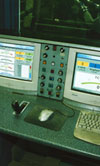Never Assume Anything
 Here’s a word of warning for you which highlights the importance of getting the basics right. The author recently visited a company who run a small water brake dynamometer for training purposes.
Here’s a word of warning for you which highlights the importance of getting the basics right. The author recently visited a company who run a small water brake dynamometer for training purposes.
The company recently came into possession of a brand new 4-cylinder Honda road car engine, donated to them by Honda as the car it had come from could not be sold and therefore needed to be disposed of.
They were delighted; the Honda would replace an ageing Ford engine which had seen better days and the new engine would give the technicians a bit of a change.
The company in question installed the Honda engine on the dynamometer, modified the fuel, oil and water systems to suit, built a new control board onto which they installed the car instrumentation, throttle pedal and ignition switch.
They were all ready to go and went for the fire up, only to find that there was no output from the dynamometer rev counter and the load figure seemed a bit random.
Subsequent investigation quickly identified the problem; the Honda engine ran in the opposite direction to every other engine the company had ever dealt with, anti-clockwise when viewed from the front (the non-output end). Within a short time, the dynamometer was (literally) turned around and rebuilt and no damage was done, but it left a clear lesson; never assume anything.
The give away from the cut away drawing is obviously the timing belt; the tight side is to the left and the slack side, with the tensioner in it, is to the right. Not that this company would be the first to make this mistake.
It is always worth checking that things are going the right way round; the author once encountered a gear type oil pump which pumped in the wrong direction because its designer assumed that oil passed between the two shafts rather than around the outside.
Alternators are another classic example. Although they will generate electrical power whilst rotating in either direction, the cooling fans are typically directional.
Bi-directionality is one of the advantages of an eddy current dynamometer, and that can be a surprisingly useful feature for a company who test a variety of engines.
Written by Tom Sharp.